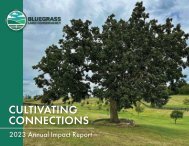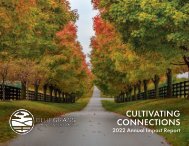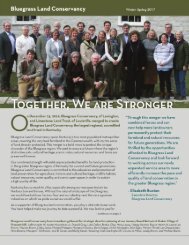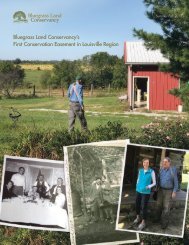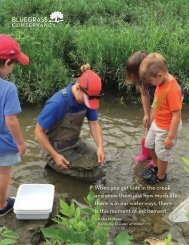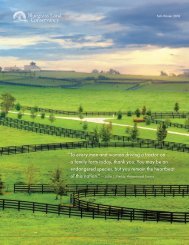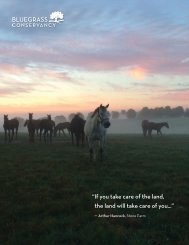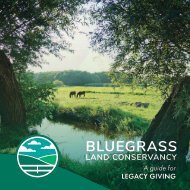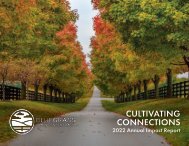BLC Conservation Easement Landowner Guide
A guide for Kentucky landowners: - What is a Conservation Easement? - Financial Benefits of Conservation Easements - About Land Trusts - Frequently Asked Questions - Landowner Stories
A guide for Kentucky landowners:
- What is a Conservation Easement?
- Financial Benefits of Conservation Easements
- About Land Trusts
- Frequently Asked Questions
- Landowner Stories
Create successful ePaper yourself
Turn your PDF publications into a flip-book with our unique Google optimized e-Paper software.
The Bluegrass region of Kentucky, with its prime soils, productive farmland,<br />
and prosperous horse operations, is internationally recognized for its<br />
agricultural resources and scenic beauty. The landscape and rich cultural<br />
heritage spanning the area between Lexington and Louisville contribute to the<br />
quality of life and economy of the Bluegrass region, making it an extraordinary<br />
place to live, work, and play.<br />
However, the Bluegrass landscape is changing. Subdivision and development<br />
of agricultural and natural lands into residential and commercial spaces is<br />
occurring at an alarming rate. With one of the highest rates of land loss in the<br />
country, the Bluegrass region is steadily losing its natural habitats, productive<br />
agricultural lands, and scenic open spaces.<br />
Private landowners own and manage more than 95% of land in Kentucky. The<br />
continued fragmentation of these lands significantly impacts family-owned<br />
properties. Family-owned farms, natural, and recreational lands make up 97%<br />
of Kentucky’s private lands and are negatively affected by changing economics<br />
and the increasing tax burden of owning property. Passing on a family farm or<br />
ranch to the next generation, whether within a family or to another family, is a<br />
time-honored tradition. For many Bluegrass landowners, their property is much<br />
more than a financial asset; it is part of their family history, their community, and<br />
the region’s natural and cultural heritage.<br />
This guidebook is intended to help Bluegrass landowners understand one of<br />
the most flexible and effective tools available to conserve and protect private<br />
property—the conservation easement. A conservation easement is a voluntary<br />
legal agreement that ensures a property will be conserved and maintained for<br />
generations to come.<br />
Every conservation easement is individually crafted and reflects the special<br />
conservation values of the land protected, as well as the needs and desires<br />
of the landowner for continued management and stewardship. <strong>Conservation</strong><br />
easements can assist landowners who wish to permanently protect their<br />
farmland, wildlife habitat, open space, water resources, scenic views, historic<br />
buildings, or archaeological sites. Some conservation easements may be<br />
purchased, however most may qualify the landowner for significant tax benefits.<br />
Each agreement is tailored to meet a landowner’s specific needs, whether he<br />
or she owns 1,000 acres of natural lands or 100 acres of farmland.<br />
This guidebook also profiles several landowners, each of whom has used a<br />
conservation easement to protect some portion of their land. These profiles<br />
illustrate how conservation easements help people conserve their privately<br />
held lands and waters for agricultural production, wildlife habitat protection,<br />
open space, and water quality protection—now, and for the benefit of future<br />
generations.<br />
5




